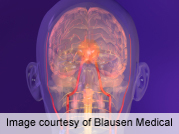
MONDAY, Oct. 8 (HealthDay News) — A new drug that researchers hope will reduce brain damage after a stroke appeared safe and effective in a small trial.
The drug, currently dubbed NA-1, helped reduce the number of brain lesions in patients who had undergone surgery for a brain aneurysm, Canadian researchers report. A brain aneurysm is an abnormal bulge, or weak spot, in the wall of an artery in the brain.
“Treatment with NA-1 compared to placebo reduces the number of small strokes among patients undergoing endovascular aneurysm repair,” said lead researcher Dr. Michael Hill, from the University of Calgary’s Hotchkiss Brain Institute.
It might be three to four years before the drug would be available for use, Hill noted. “The trial is a proof-of-concept study showing that NA-1 could be an adjunct treatment to stroke,” he explained.
Neuroprotection is possible in stroke treatment, Hill said, “we just have to figure out how and when to give the drug — it is likely to be critical that it be given early.”
The report was published in the Oct. 8 online edition of The Lancet Neurology.
For the study, Hill’s team randomly assigned 185 patients to NA-1 or an inactive treatment called a placebo. Within three days and a month after the aneurysm operation, patients underwent scans to measure the extent of brain tissue damage.
There were significantly fewer lesions in the brains of those given the drug, compared with those given the placebo, the researchers found. And the side effects were minimal, with only a few patients experiencing low blood pressure.
Experts said the drug is showing early promise.
“After prevailing worldwide nihilism that neuroprotecting drugs are dead in treatment of patients with stroke, there seems to be again light in the corridor,” said Dr. Markku Kaste, from the department of neurology at Helsinki University Central Hospital in Finland and author of an accompanying journal editorial.
“If additional large, well-designed and executed trials are positive, we may finally have a treatment which improves the outcome of stroke patients and which can be delivered not only at well-functioning stroke services but almost anywhere,” he said.
Kaste noted that if this drug’s potential is verified, it could be an important addition to treating stroke throughout the world.
“The burden of stroke is huge and increasing worldwide,” he said. “Most strokes occur in developing countries, which do not have expertise and resources for modern effective acute stroke care.”
Only a minority of patients in developing countries have access to stroke unit care and even fewer will receive expensive clot-busting drugs, Kaste said.
“There is a great need for treatments which can be administered at a low-service level,” he said. “Hill and co-workers were able to show that such a treatment may exist in the future.”
Another expert, Dr. Ralph Sacco, chairman of neurology at the University of Miami Miller School of Medicine, said that “it is too early to consider use of this drug among patients at risk of stroke after aneurysm treatments.”
Neuroprotective drugs have been tested for some time and shown amazing effects in animals, but none have been demonstrated to be of any proven value among human stroke patients.
“That is what is novel about this early trial,” Sacco said. “All the patients were at risk of stroke after aneurysm treatment and could be pretreated. We hope that these encouraging findings will be pursued in further trials to evaluate this potential neuroprotective treatment,” he said.
More information
For more on stroke, visit the American Stroke Association.

